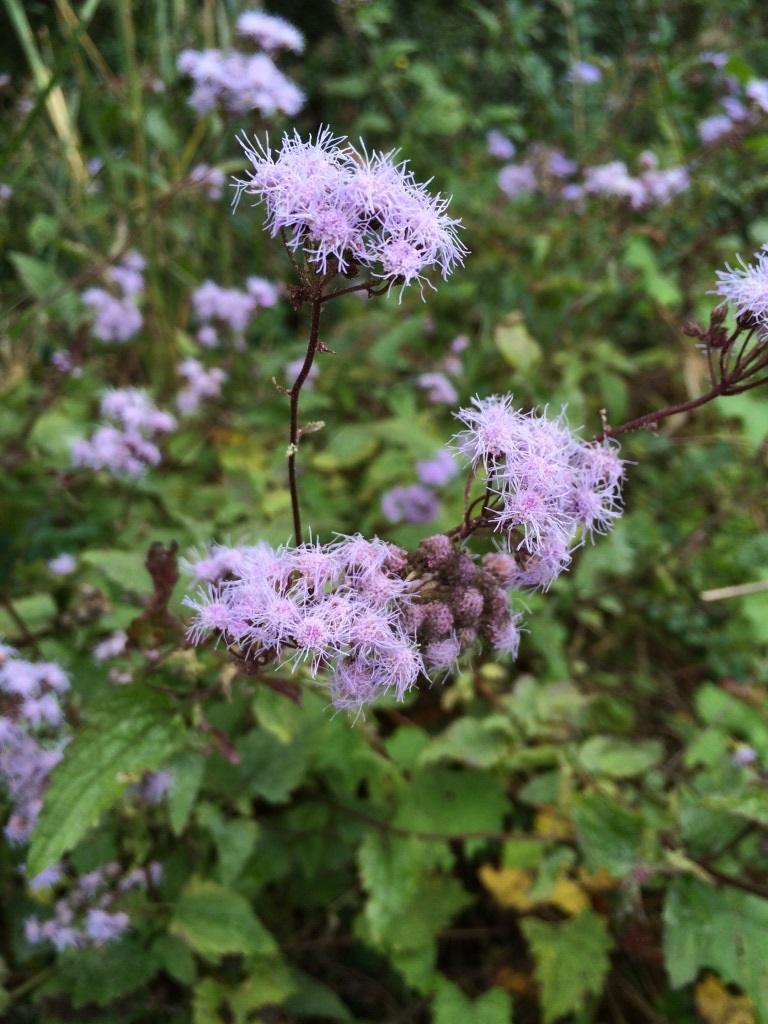
by Mary Salinas | Nov 18, 2014
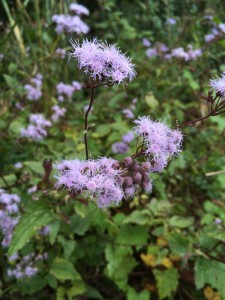
Blue Mistflower – Image Credit Mary Derrick, UF / IFAS
Here’s a beautiful native perennial wildflower that is easy to grow and generally available in the independent nursery trade. In the wild, you can encounter them at the edges of woodlands and ponds as they prefer moist areas. Blue mistflower, Conoclinium coelestinum, performs well as a perennial in the home landscape but does spread easily by seed and will spread in the garden. It also spreads through underground rhizomes which allow it to form large clumps. This is an advantage for the informal garden, however, the gardener who prefers a more formal look will have a bit more maintenance in controlling that spread.
The abundant flowers look like bluish-purple puffballs on the top of the stems. The color is unusual and adds a striking touch in the garden. The bloom season is mid-summer to mid-fall. Butterflies are frequent visitors, making this an excellent addition to your butterfly garden.
Blue mistflower has a full rounded form and will grow to 3 feet under optimum conditions. Leaves are opposite and have a triangular shape. Growth and blooming is best in full sun to part sun conditions.
Give it a try!
by Taylor Vandiver | Oct 7, 2014
I think it’s safe to say fall is officially here. Shouts can be heard from local football stadiums, occasionally a crisp fall breeze will send us looking for a light jacket, and coffee shops are pushing all things pumpkin. Now that we can officially appreciate the cooler fall weather, it may be time to stretch our legs and marvel at the spectacular show of color our landscapes are putting on. Here are a few plants that are showing off this time of year.
Firebush (Hamelia patens) – This charming Florida native will delight everyone with beautiful orange-red flowers throughout most of the year. Hummingbirds and butterflies enjoy the nectar in the flowers. Firebush can reach a height and width of 8 to 12 feet. It is a fast growing plant that will grow well in part to full sun environments.
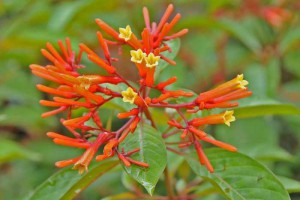
Bright orange-red blooms on a firebush. Photo courtesy UF/IFAS.
Salvia (Salvia spp.) – Salvias are great plants for bringing butterflies and hummingbirds to your garden and as a bonus, they have no serious pests. With hundreds of annual and perennial species coming in an array of colors and sizes, you can easily find one or more to complement your landscape. Salvias perform best in full sun environments and are considered drought tolerant.
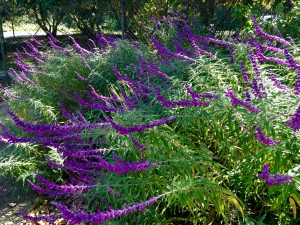
Deep purple blooms on a salvia in the landscape. Photo courtesy Taylor Vandiver.
Turk’s Cap (Malvaviscus arboreus) – Turk’s cap can add a cheerful pop of color at a time when little else is blooming. This old-fashioned Florida-Friendly shrub like perennial is related to the hibiscus. It’s known for its bright red flowers that always seem ready to open, but never do. Turk’s cap starts blooming in summer and keeps going until through winter, unless hit by a hard frost. It can grow in full sun and reach up to ten feet tall and ten feet wide, so give it room to grow. This easy-care native perennial requires little maintenance once it’s established.
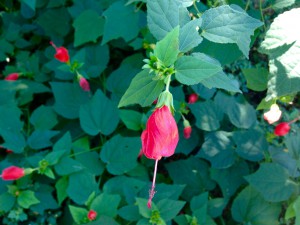
Turk’s cap showing off its unique blooms. Photo courtesy Taylor Vandiver
Coleus (Solenostemon scutellarioides) – When imagining fall color we often don’t consider coleus. However, the vibrant foliage can add interest to any landscape throughout the fall. Coleus is prized for its colorful foliage, which comes in shades of green, yellow, pink, red, and maroon. Coleus varieties can range from one to several feet in height. They can be used in hanging baskets, containers on patios, or in landscape beds. Coleus prefers partial shade and you can pinch the growing stems of young plants frequently to encourage dense foliage. Keep an eye out for mealybugs on coleus and use insecticidal soap if problems develop
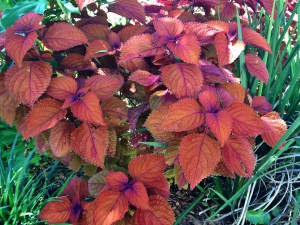
Burnt orange foliage standing out amongst the neutral green of the landscape. Photo courtesy Taylor Vandiver.
Fore more information contact your local extension agent. Also you can visit us at gardeningsolutions.ifas.ufl.edu or edis.ifas.ufl.edu.
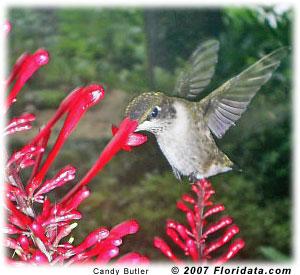
by Sheila Dunning | Sep 23, 2014

Photo Credit: Candy Butler, Floridata.com
Looking to add something to brighten your landscape this autumn? Firespike (Odontonema strictum) is a prolific fall bloomer with red tubular flowers that are very popular with hummingbirds and butterflies. Its glossy dark green leaves make an attractive large plant that will grow quite well in moderate shade to full sunlight. In frost-free areas firespike grows as an evergreen semi-woody shrub, spreading by underground sprouts and enlarging to form a thicket. In zones 8 and 9 it usually dies back to the ground in winter and resprouts in spring, producing strikingly beautiful 9-12 inch panicles of crimson flowers beginning at the end of summer and lasting into the winter each year. Firespike is native to open, semi-forested areas of Central America. It has escaped cultivation and become established in disturbed hammocks throughout peninsular Florida, but hasn’t presented an invasive plant problem. Here in the Panhandle, firespike will remain a tender perennial for most locations. It can be grown on a wide range of moderately fertile, sandy soils and is quite drought tolerant. Firespike may be best utilized in the landscape as a mass planting. Plants can be spaced about 2 feet apart to fill in the area quickly. It is one of only a few flowering plants that give good, red color in a partially shaded site. The lovely flowers make firespike an excellent candidate for the cutting garden and is a “must-have” for southern butterfly and hummingbird gardens. Additional plants can be propagated from firespike by division or cuttings. However, white-tailed deer love firespike too, and will eat the leaves, so be prepared to fence it off from “Bambi” if they are a problem in your neighborhood.
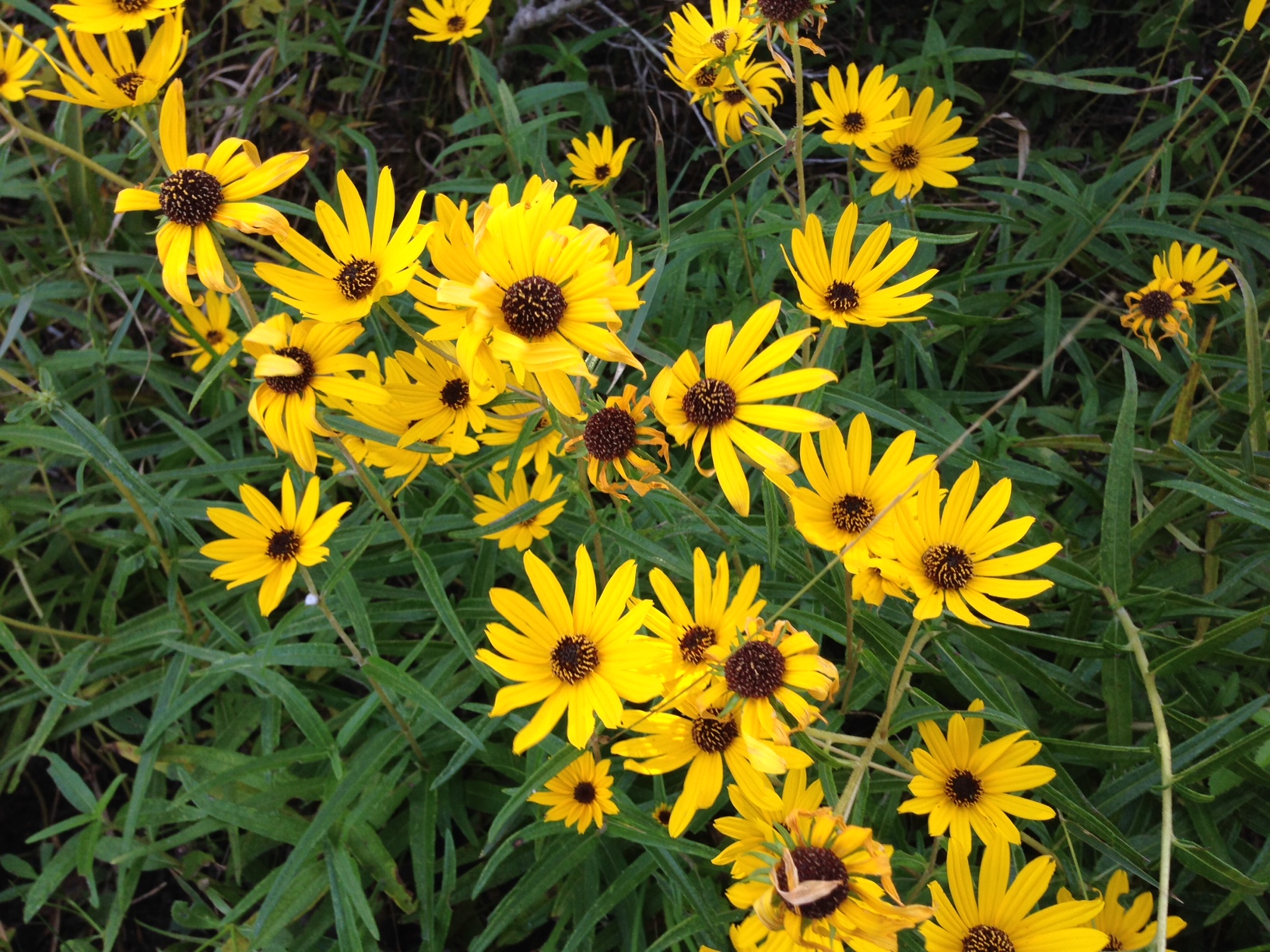
by Mary Salinas | Sep 23, 2014
In the midst of your September strolls through natural Florida, you may come across this native beauty, the narrowleaf sunflower, Helianthus angustifolius. Another common name is swamp sunflower. I found this gorgeous patch in the photo close to the shore of Apalachicola Bay. It occurs throughout Florida and north throughout much of the eastern United States. Florida is fortunate to be home to over 20 native species of sunflower.
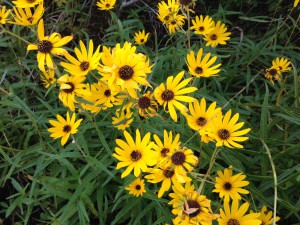
Narrowleaf Sunflower. Photo credit: Mary Derrick, UF/IFAS Extension.
This perennial starts blooming in late summer and dazzles admirers throughout autumn. The 2 to 3 inch flowers with bright yellow petals and brown centers are attractive to butterflies and other pollinators. What a great addition to your butterfly garden!
Plants generally grow to about 2 foot tall but they can grow a bit leggy to 6 foot. If desired, keep them more compact through pruning in late spring. Clumps can be divided every few years to spread them out or to share with friends and neighbors.
Like all sunflowers, it loves full sun but can tolerate some light shade. Narrowleaf sunflower is salt and flood tolerant and will do well in most soil types, however it does best in consistently moist conditions.
Narrowleaf sunflower plants may be difficult to find in the nursery trade but they can be readily started from seed.
For more information and seed sources:
Florida Wildflower Foundation
Atlas of Florida Vascular Plants: Helianthus species
Common Native Wildflowers of North Florida
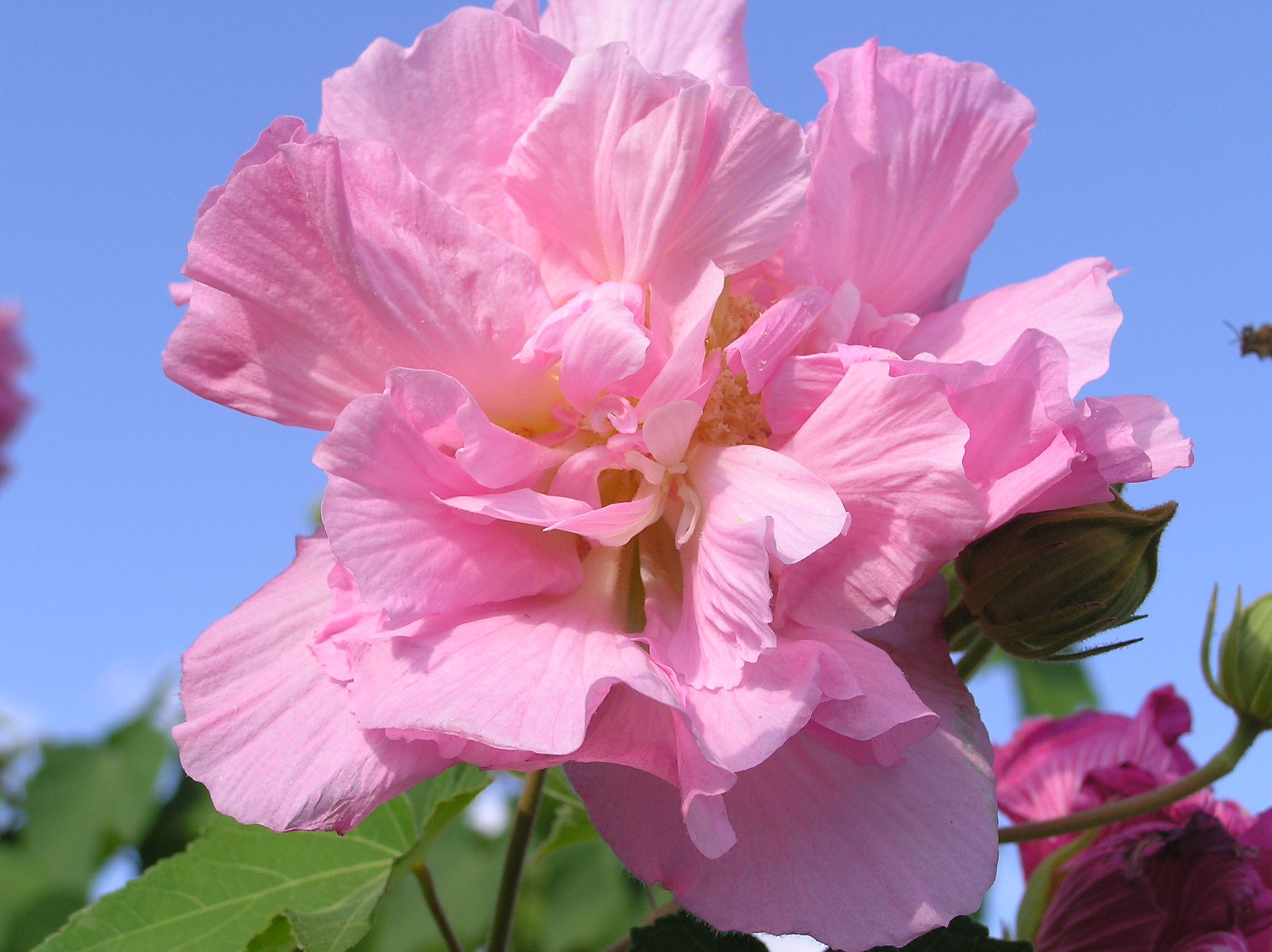
by Larry Williams | Sep 9, 2014
What plant is found mostly in older landscapes but is poorly available in most local nurseries, is closely related to okra and cotton but is called a rose and produces showy fall flowers that turn from white to pink or red? Give up?
The plant is commonly called confederate rose. Some people call it cotton rose. Its botanical name is Hibiscus mutabilis.
Confederate roses usually begin blooming in late summer and continue to flower well into fall.
Even though it’s frequently referred to as confederate rose, it’s not a member of the rose (rosaceae) family. It belongs to the mallow (malvaceae) family, which includes numerous ornamentals, cotton and okra.
It is a true hibiscus. But, unlike many other ornamental hibiscus species, for some reason it is not usually found in most local garden centers. The plant finds its way into other landscapes simply by one gardener sharing a cutting with another gardener.
It’s easy to propagate. New plants can be started in spring from seed or from 8 inch long terminal cuttings taken during spring, summer and early fall. Cuttings can be rooted in a conventional propagation bed or even in a glass of water.
There are several forms of confederate roses. The cultivar known as ‘Rubus’ has deep pink flowers. ‘Plena’ has double white flowers that change to pink or red on the second day. The older, original types have double flowers that open white in the morning and gradually turn pink in the afternoon.
Even though confederate rose is not very impressive during spring and summer with its cotton or okra like leaves, you may find it a worthwhile landscape plant as it produces its large flowers (some up to 6 inches across) in late summer and fall.
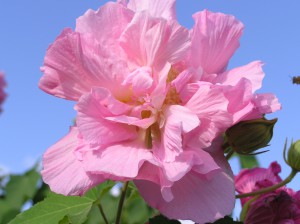
Confederate rose in bloom, Photo Credit: Santa Rosa County Extension
With proper care, a confederate rose should grow into a 15-foot tall bush during a single season. But expect the entire plant to be killed to the ground during the winter. But it usually sprouts rapidly from the crown the following spring. Be careful, too much fertilizer can result in lots of leaves but few blooms.
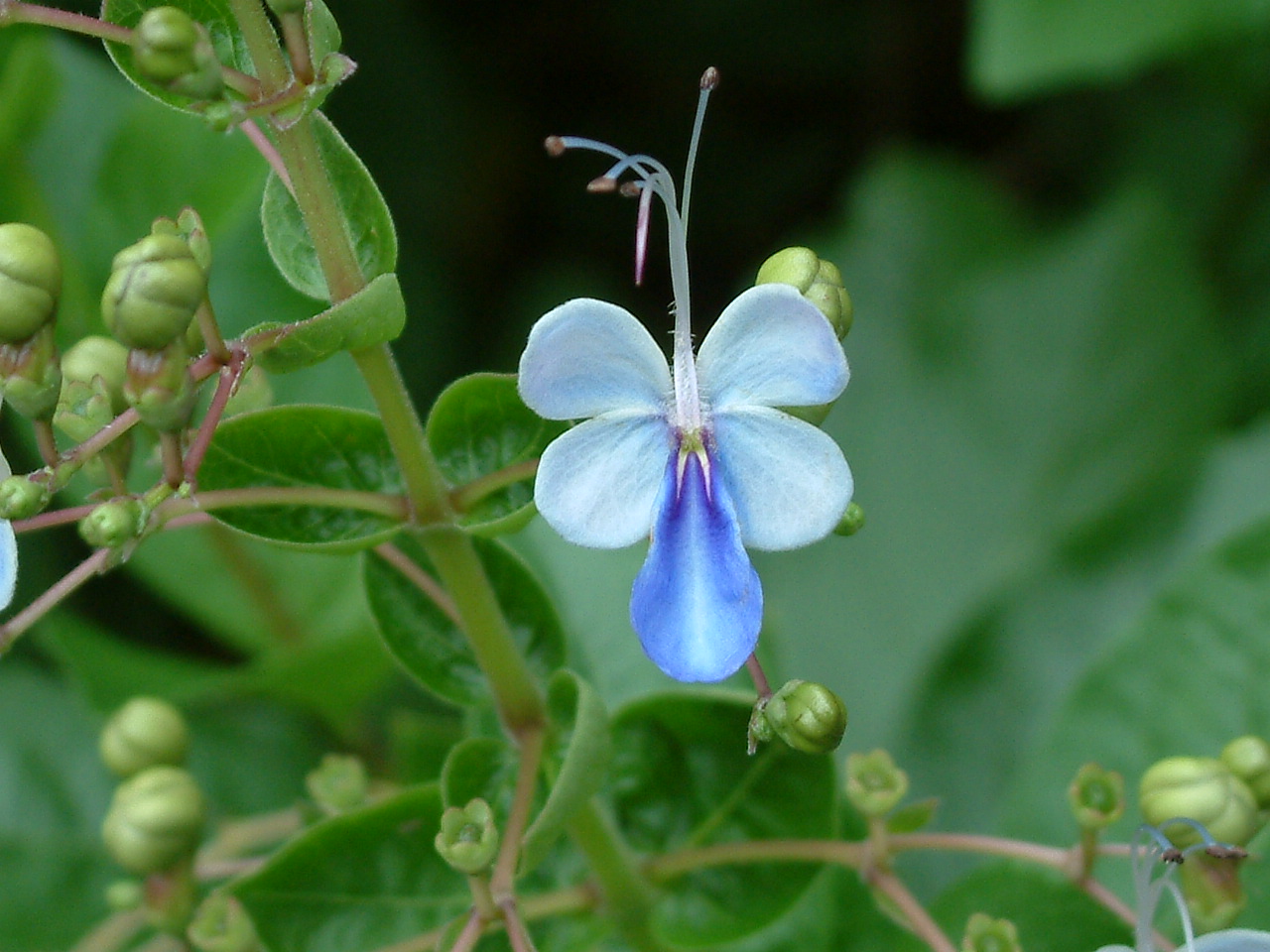
by Beth Bolles | Sep 2, 2014
Many species of butterflies are flitting through summer gardens but a special butterfly has recently made its appearance in perennial gardens. The Blue butterfly bush, Clerodendrum ugandense is a mid to late summer blooming plant that has unique flowers resembling butterflies.
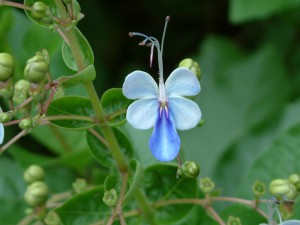
Photo: Beth Bolles, UF IFAS Extension Escambia County
During our hottest days, light blue flowers appear above attractive green foliage. Plants may grow between 6 and 10 feet in height when provided with partial shade and moisture during the warm season. Although butterfly bush is a frost sensitive plant, it will likely return from the roots in hardiness zones 8 and 9. Even when replanted in the spring, it grows well enough that you will enjoy a flowering display by summer’s end. Plant your butterfly bush to accommodate a spreading growth habit and where garden visitors can get a close view of the interesting flowers.

Flower panicles. Photo: Beth Bolles, UF IFAS Extension Escambia County














